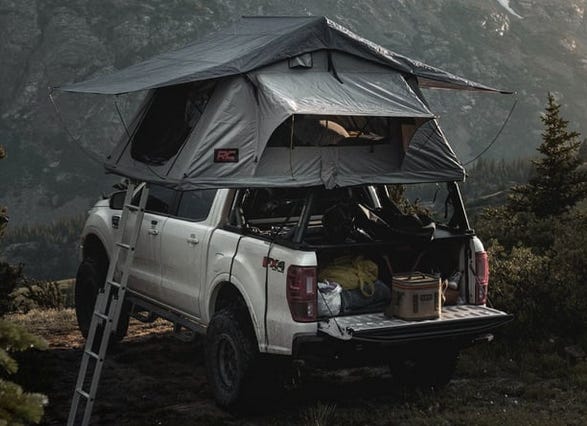Use Your Entire Vehicle For A Generator In An Emergency
It's easier than you would expect compared to other approaches and it is sufficiently well tested to be trustworthy in the field, not just in theory

A parked vehicle can be used as a temporary, emergency generator. By connecting an inverter to the car battery, you can convert the car's DC power to AC power and run household appliances. It's important to note that this method is best suited for powering essential devices and should be done with the vehicle's engine running to recharge the battery.

USING AN INVERTER FOR HEAVY LOADS
1. The Role of the Inverter:
A car battery provides direct current (DC) power, while most household appliances use alternating current (AC) power.
An inverter is a device that converts DC power from the battery into AC power, allowing you to plug in devices that would normally be used with a wall outlet.
There are different types of inverters, including modified sine wave and pure sine wave. Modified sine wave inverters are suitable for many devices but might not be ideal for sensitive electronics.
Where the demand is low enough, for requirements like basic lights and radio on 12 volts, there is no need to connect the inverter to the battery. It can be plugged into one of the 12 volt jacks available inside the vehicle.
For heavier loads, it will be safer over a long term to connect to the battery terminals.
2. Connecting the Inverter:
If the demand is heavy, the inverter needs to be connected to the car battery. This usually involves attaching red (positive) and black (negative) clamps to the corresponding terminals.
It's recommended to use thicker gauge wires for the connection to prevent overheating or damage, especially when powering larger devices.
When connecting, ensure that the engine is off to avoid potential electrical hazards.
Once the inverter is connected, you can plug extension cords into the inverter and then into your devices.
3. Running the Engine:
While the inverter can draw power from the battery, the battery's capacity is limited.
To maintain a consistent power supply and prevent the battery from draining, it's crucial to run the vehicle's engine while the inverter is in use.
The engine's alternator will recharge the battery while the vehicle is running.
Idling the engine will provide enough power to recharge the battery and run the inverter, but it's recommended to check the alternator's specifications and ensure it's not overloaded.
4. Safety Precautions:
Ventilation: Ensure proper ventilation when running the engine, especially in enclosed spaces, to prevent carbon monoxide buildup.
Wire Management: Keep the wires connected to the inverter secured and away from moving parts of the engine.
Voltage Monitoring: Monitor the car's voltage to ensure it doesn't drop too low (below 11.2 volts, for example).
Device Compatibility: Be mindful of the power requirements of your devices and ensure they are compatible with the inverter's output.
5. Benefits of Using a Vehicle as a Generator:
Cost-effective: A vehicle can be a more affordable alternative to a traditional generator, especially for short-term power outages.
Portability: Cars and trucks are generally mobile and can be moved to a more convenient location for power generation.
Quieter Operation: Using a vehicle's engine to power the inverter can be quieter than a traditional generator.
Fresh Fuel: Vehicles typically have a larger fuel tank than portable generators, and the fuel is likely to be fresher due to regular driving.
Multiple Power Sources: Vehicles can also provide power through USB ports and 12V power outlets, allowing you to charge smaller devices directly.
There are real world examples of people who fled their homes during disasters and used their vehicles to power their electrical needs for weeks or even months. Only running the vehicle when absolutely necessary can conserve the fuel and the charge for months before one or the other runs out. Even then, the battery can be charged with an inexpensive solar panel on the roof of the car.

It’s a good strategy when conservation is practiced and the fumes from the exhaust while running the car are safely ventilated. Obviously you would not want the exhaust pointed into your refuge, cabin or shelter nearby because of the dangers of carbon monoxide.
It is not a last resort, rather a good practice during a bug-out to turn to your car to charge your devices and power critical equipmment that may be needed. Just remember to treat your existing fuel in the tank as a resource that has to be judiciously conserved in these operating conditions.
Regards, Tex




Good & important article, I remember that James Dakin (Aka Bison, from the Bison Survival letter) had a setup based on car/marine batteries that he loaded up with his truck when driving from his permanent bugout place to the town, he went in great detail about it. I remember that he explained how 12V car lights were the most effective.
The car genrator is however too complicated to convert for manaul / foot pedal cycling. On Amazon / Ali Baba you can find a 20W manual generator with several outgoing tensuions, including USB ports, for about 30 USD.
During the occuption in France (and even before, in some fortifications) batteries were charged by pedaling on a midified bicycle. It has the advantage of not being noticeable from the outside.
Thanks for this information.
Having a diesel truck is ideal since you can keep it running for hours on end and not worry about harming the engine as you would with a gas engine. Plus, a diesel engine is far more efficient in its idle mode with fuel consumption vs. a gas engine. Yet, there are fumes to contend with as well as a louder motor in a diesel engine. So if staying hidden is a goal…gas engines might win the day. But, I love Solsys’ comment about the bicycle if you’re in a pinch!